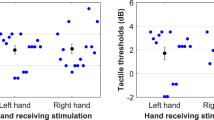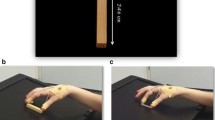Abstract
Previous evidence indicates that, when reaching to grasp a target object, the presence of nontarget irrelevant information (i.e., distractor) presented either in the visual or olfactory modality determines significant interference effects on temporal parameters, such as reaction time and movement time, and on movement kinematics. While research on “visual” distractor has also revealed that such interference effects disappear when prior knowledge about the target is given to participants, this aspect for olfactory distractors has yet to be investigated. Therefore, here we asked participants to reach towards and grasp a small or a large visual target following the delivery of an odor evoking either a small or a large object. When the type of grasp evoked by the odor did not coincide with that for the visual target, interference effects were evident on reach duration and reaction time, but kinematics of hand shaping remained unaltered. This study demonstrates that, when participants knew in advance which object was the target, olfactory nontargets produced no interference effects on movement kinematics, but they did on key temporal measures, i.e., reaction time and reach duration. These findings are discussed in light of current theories put forward to explain the sensory processes underlying the control of action.



Similar content being viewed by others
References
Ansuini C, Tognin V, Turella L, Castiello U (2007) Distractor objects affect fingers’ angular distances but not fingers’ shaping during grasping. Exp Brain Res 178:194–205
Castiello U (1996) Grasping a fruit: selection for action. J Exp Psychol Hum Percept Perform 22:582–603
Castiello U (1998) Attentional coding for three-dimensional objects and two-dimensional shapes. Differential interference effects. Exp Brain Res 123:289–297
Castiello U, Zucco GM, Parma V, Ansuini C, Tirindelli R (2006) Cross-modal interactions between olfaction and vision when grasping. Chem Senses 31:665–671
Castiello U, Tubaldi F, Ansuini C, Giordano B, Grassi M (2007) Multisensory integration during grasping movements. In: Proceed Italian Soc Psychophysiol Conference, p. 3
Chieffi S, Gentilucci M, Allport A, Sasso E, Rizzolatti G (1993) Study of selective reaching and grasping in a patient with unilateral parietal lesion. Dissociated effects of residual spatial neglect. Brain 116:1119–1137
Hick WE (1952) On the rate of gain of information. Q J Exp Psychol 4:11–26
Hummel T, Knecht M, Kobal G (1996) Peripherally obtained electrophysiological responses to olfactory stimulation in man: electro-olfactograms exhibit a smaller degree of desensitization compared with subjective intensity estimates. Brain Res 717:160–164
Jackson SR, Jackson GM, Rosicky J (1995) Are non-relevant objects represented in working memory? The effect of non-target objects on reach and grasp kinematics. Exp Brain Res 102:519–530
Lhermitte F (1983) “Utilization behavior”, and its relation to lesions of the frontal lobes. Brain 106:237–255
Meegan DV, Tipper SP (1998) Reaching into cluttered visual environments: Spatial and temporal influences of distracting objects. Q J Exp Psychol 51A:225–249
Patchay S, Haggard P, Castiello U (2005) Cross-modal links in action: Evidence for an object-centred reference frame for control of grasping. Exp Brain Res 23:1–11
Pratt J, Abrams RA (1994) Action-oriented inhibition: effects of distractors on movement planning and execution. Hum Mov Sci 13:245–254
Rossi S, De Capua A, Pasqualetti P, Ulivelli M, Fadiga L, Falzarano V, Bartalini S, Passero S, Nuti D, Rossini PM (2008) Distinct olfactory cross-modal effects on the human motor system. PloS ONE 3:e1702
Tipper SP, Lortie C, Baylis GC (1992) Selective reaching: evidence for action-centered attention. J Exp Psychol Hum Percept Perform 18:891–905
Tipper SP, Howard LA, Jackson SR (1997) Selective reaching to grasp: evidence for distractor interference effects. Vis Cogn 4:1–38
Tipper SP, Howard LA, Houghton G (1998) Action-based mechanisms of attention. Philos Trans R Soc Lond B Biol Sci 353:1385–1393
Tubaldi F, Ansuini C, Demattè ML, Tirindelli R, Castiello U (2008a) Effects of olfactory stimuli on arm-reaching duration. Chem Senses 33:433–440
Tubaldi F, Ansuini C, Tirindelli R, Castiello U (2008b) The grasping side of odours. PLoS ONE 19(3):e1795
Author information
Authors and Affiliations
Corresponding author
Rights and permissions
About this article
Cite this article
Tubaldi, F., Ansuini, C., Tirindelli, R. et al. The Effects of Task-Irrelevant Olfactory Information on the Planning and the Execution of Reach-to-Grasp Movements. Chem. Percept. 2, 25–31 (2009). https://doi.org/10.1007/s12078-009-9039-3
Received:
Accepted:
Published:
Issue Date:
DOI: https://doi.org/10.1007/s12078-009-9039-3




